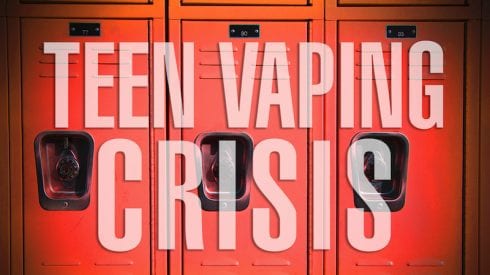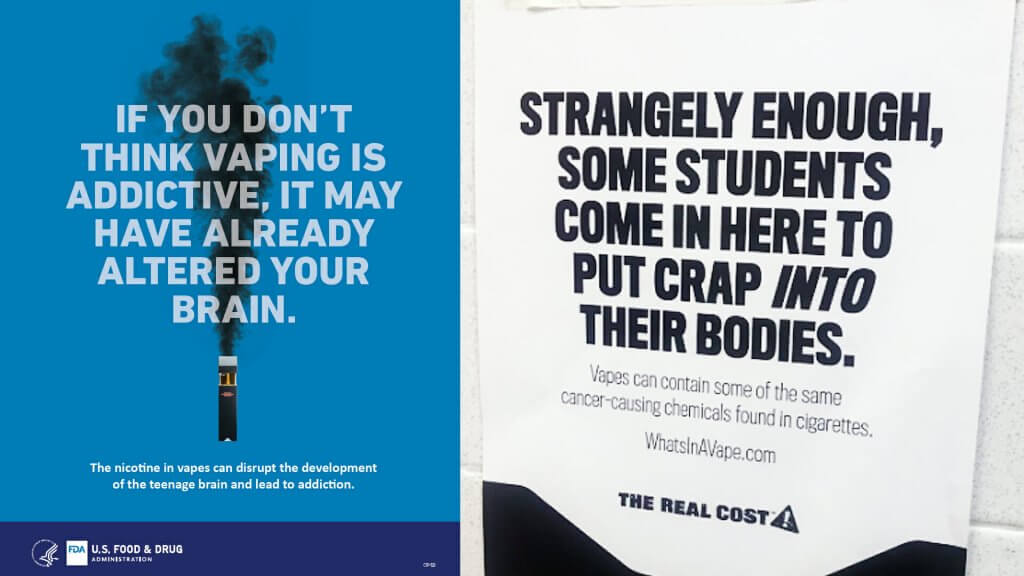
Steps Schools Can Take to Prevent and Reduce Teen Vaping
- Start Tobacco Education Classes Education is one of the most effective preventative measures when it comes to nicotine use. ...
- Peer-to-Peer Education While class-wide or school-wide education efforts can help prevent vaping, peer-to-peer education may be even more effective. ...
- Getting Parents Involved in Tobacco-Related Education ...
Is vaping in schools really a problem?
Students share that it is fairly easy to discreetly vape in class, and that’s a huge problem. However, it can be mitigated with some staff training.
Is vaping a problem at your school?
Myth: There are no secondhand smoke risks from vaping. Fact: Like secondhand vapor, secondhand vapor is harmful. When kids are vaping in a school bathroom, others who enter the room inhale the nicotine and the harmful metals and chemicals.
How often should I be Vaping?
If you are just vaping to blow clouds, you should avoid the Nicotine, and just vape whenever. As often as you like. Usually when you first quit smoking, you vape a lot, pretty much at any thought of smoking, which is good; it allows your brain to see that vaping is a good replacement for smoking.
What can schools do to prevent cyberbullying?
The ideal model is a school that incorporates digital citizenship lessons into the school day. A few other things schools can do to help prevent cyberbullying: Start from the ground up. Build a community that rewards kindness and compassion, not only academic or athletic achievement. Use the Internet in lesson plans.

What is the most popular tobacco product among high school students?
E-cigarettes are the most popular tobacco product among high school students and they are on the rise with elementary children, so it’s no surprise that they’ve made their way onto school campuses. E-cigarettes are especially appealing to kids, and, since many look like everyday objects, they’re easy to hide.
Should schools have e-cigarette policies?
You should specifically address e-cigarettes in your policy, but make sure they aren’t punitive. This isn’t as much a discipline issue as a rehabilitation one. Instead of exclusionary discipline like in-school suspension, consider having students participate in interactive educational sessions like INDEPTH. Schools also need to have programs and counseling available on-site to help kids quit and support them through that process. This K-12 model policy is a great place to start.
Can students vape in class?
Students share that it is fairly easy to discreetly vape in class, and that’s a huge problem. However, it can be mitigated with some staff training. All administrators, teachers, and staff should be familiarized with the different types of products on the market (some even look like watches!), the harm they cause to lungs and developing brains, and the susceptibility of adolescents to addiction.
How does vaping help youth?
One study among students aged 14 to 19 found that many participants quit smoking after peer education. Researchers also noted that the program helped to develop positive relationships between peers.
How many high school students use e-cigarettes?
adults in 2019 . Yet, e-cigarette and vaping use among high school and middle school students rose – nearly 27.5% of high school students and 10.5% ...
Do parents have to be involved in vaping?
Staff and parent or guardian education and participation are necessary, too. They need to know the warning signs of vaping and how to intervene. Many families believe their children aren’t vaping.
Is vaping a health risk in school?
Whether school this year is online or in-person, vaping remains a dangerous health risk to all students. Despite statewide bans on certain e-cigarettes ...
How can we reduce vaping?
The first step in reducing childhood demand for vaping products is to build awareness of the significance of the problem. Governments in America and elsewhere are experimenting with anti-vaping campaigns to help spread the message through media. These campaigns will probably get bigger (and hopefully more effective) as government representatives respond to the pressure to do something quickly.
What Is Vaping?
Although cigarettes remain the world's main delivery vehicle for nicotine as of 2019, there are now many electronic nicotine delivery systems (ENDS), known by many names: e-cigarettes, pods, e-cigs, vape pens, and other evolving names, including the brand name Juul. These products were initially developed and marketed as a healthier alternative for smokers trying to quit, but at this point it's clear that they also play a role in getting new customers to start, including children.
How Dangerous Is Vaping and Nicotine?
Nicotine-laced vapors have been presumed to be less toxic than tobacco smoke, which is why people trying to quit cigarettes have found them of interest. But they are not benign, especially for children, including teens. Nicotine interferes with brain development. Vaping devices degrade with use, adding toxic metal nanoparticles to the haze.
What Can School Boards Do?
Boards and administrators are faced with the challenge of balancing demands for "zero tolerance" enforcement with the reality that some of their students and faculty may be struggling with addiction.
What is a vaping device?
The Center on Addiction describes a vaping device as consisting of "a mouthpiece, a battery, a cartridge for containing the e-liquid or e-juice, and a heating component … which turns the contents of the e-liquid into an aerosol. The e-liquid in vaporizer products usually contains a propylene glycol or vegetable glycerin-based liquid with nicotine, flavoring and other chemicals and metals, but not tobacco."
How can parents help their kids with addiction?
Counselors and psychologists with expertise in addiction tend to encourage calm, informed conversations rather than heated threats or punishment. Ultimately, people make their own decisions at any age, and for adolescents a sense of independence tends to be pretty important. Vaping is a pretty dumb habit, and kids tend to know it, but there can be many reasons why quitting could be hard. The blog Empowering Parents has some useful verbage to help parents prepare, so that a conversation can be helpful.
Is vaping safer than smoking?
The decline of smoking is being matched by a rapid rise in "vaping," a less-obtrusive system for inhaling vapor spiked with nicotine. Vaping companies position these products as safer than tobacco — a claim now under investigation by the FDA. (Vaping tools can be used to deliver other substances, too, but let's stick with nicotine for now.) The best-known vaping brand, Juul, is substantially owned by Altria, the tobacco conglomerate that owns Phillip-Morris.
How does vaping affect teachers?
Teachers have reported youth vaping is impacting their ability to educate students because of frequent class interruptions, decreased student focus and few resources to help them address the problem, according to previous Truth Initiative ® research.
How many high school students are vaping in 2020?
With youth vaping continuing at epidemic levels – about one in five high school students were using e-cigarettes in 2020 – schools and communities have an important role to play in reaching students with the information they need to make informed choices, as well as tools to quit if they are already vaping. YouTube.
Do young people want to quit vaping?
Most young e-cigarette users want to quit vaping – a new Truth Initiative survey found 60% of young current e-cigarette users surveyed want to quit vaping within the year – signaling a pressing need to provide resources to support them.
What to do if a friend offers a cigarette?
Discuss what they might say if a friend offers a cigarette or e-cigarette. Set a good example. If you smoke or vape, the best thing you can do is quit. At a minimum, don’t smoke around your children. Establish a smoke-free home. Don’t allow family members or friends to smoke in your home or car.
How to steer kids away from tobacco?
Here are some of the most effective ways you can steer your kids away from tobacco: Maintain a dialogue. Start early — begin talking with your kids about smoking and vaping in kindergarten. Be honest and open to seeing things from your child’s point of view. And don’t stop.
What are tobacco companies targeting?
Tobacco companies are targeting young people with ads, price discounts and enticing new products such as e-cigs designed to look like sleek gadgets. Many teens and young adults exposed to these efforts are highly impressionable and dealing with social pressures to “fit in” with peers.
Can you smoke with your kids?
At a minimum, don’t smoke around your children. Establish a smoke-free home. Don’t allow family members or friends to smoke in your home or car. Make sure the places your child spends a lot of time are tobacco-free. If your child has started smoking or vaping, try to learn why.
